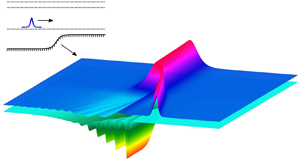Published online by Cambridge University Press: 02 December 2020

We consider the resonant coupling of mode-1 and mode-2 internal solitary waves by topography. Mode-2 waves are generated by a mode-1 wave encountering variable topography, modelled by a coupled Korteweg–de Vries (KdV) system. Three cases, namely  $(A)$ weak resonant coupling,
$(A)$ weak resonant coupling,  $(B)$ moderate resonant coupling and
$(B)$ moderate resonant coupling and  $(C)$ strong resonant coupling, are examined in detail using a three-layer density-stratified fluid system with different stratification and topographic settings. The strength of the resonant coupling is determined by the range of values taken by the ratio of linear long-wave phase speeds (
$(C)$ strong resonant coupling, are examined in detail using a three-layer density-stratified fluid system with different stratification and topographic settings. The strength of the resonant coupling is determined by the range of values taken by the ratio of linear long-wave phase speeds ( $c_2/c_1$, where
$c_2/c_1$, where  $c_1$ is the mode-1 speed and
$c_1$ is the mode-1 speed and  $c_2$ the mode-2 speed) while the waves are above the slope. In case
$c_2$ the mode-2 speed) while the waves are above the slope. In case  $A$ the range is from
$A$ the range is from  $0.42$ (ocean edge) to
$0.42$ (ocean edge) to  $0.48$ (shelf edge), in case
$0.48$ (shelf edge), in case  $B$ from
$B$ from  $0.58$ (ocean) to
$0.58$ (ocean) to  $0.72$ (shelf) and in case
$0.72$ (shelf) and in case  $C$ from
$C$ from  $0.44$ (ocean) to
$0.44$ (ocean) to  $0.92$ (shelf). The feedback from mode-2 to mode-1 is estimated by comparing the coupled KdV system with a KdV model. In case
$0.92$ (shelf). The feedback from mode-2 to mode-1 is estimated by comparing the coupled KdV system with a KdV model. In case  $A$, a small-amplitude convex mode-2 wave is generated by a depression mode-1 wave and the feedback on the mode-1 wave is negligible. In case
$A$, a small-amplitude convex mode-2 wave is generated by a depression mode-1 wave and the feedback on the mode-1 wave is negligible. In case  $B$, a concave mode-2 wave of comparable amplitude to that of the depression incident mode-1 wave is formed; strong feedback enhances the polarity change process of the mode-1 wave. In case
$B$, a concave mode-2 wave of comparable amplitude to that of the depression incident mode-1 wave is formed; strong feedback enhances the polarity change process of the mode-1 wave. In case  $C$, a large-amplitude concave mode-2 wave is produced by an elevation mode-1 wave; strong feedback suppresses the fission of the mode-1 wave. Simulations for a wider range of topographic slopes and three-layer stratifications are then classified in terms of these responses.
$C$, a large-amplitude concave mode-2 wave is produced by an elevation mode-1 wave; strong feedback suppresses the fission of the mode-1 wave. Simulations for a wider range of topographic slopes and three-layer stratifications are then classified in terms of these responses.